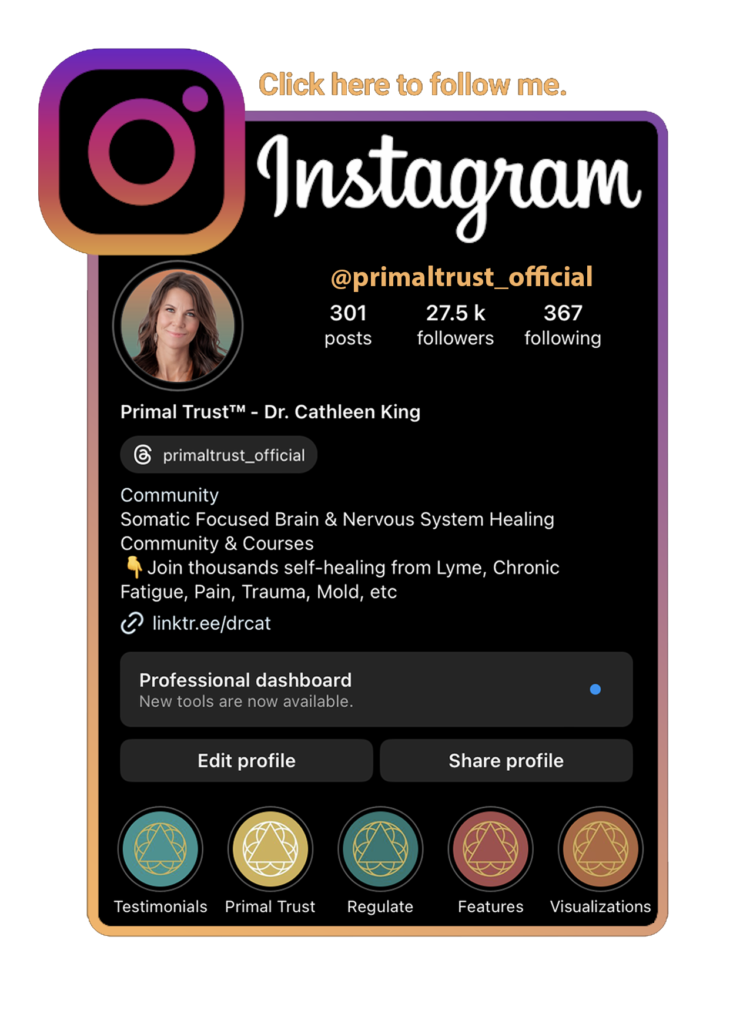I had done CFS school at the end of 2021, beginning of 2022 and made some gains such as being able to walk up to 0.7 mile. And some other emotional changes for the better. I got involved with Primal Trust’s Creating Calm in June 2022, and then Regulate when it came out in October. I started making gains from the get-go with Cathleen’s beautifully thought out combination of super effective tools program and kind and embracing presence. Since starting with Primal Trust, I have increased my walking up to 1.8 miles (current record distance). I have gone a full 1.1 mile more than I was doing before CFS school (and before CFS school I could not even walk the length of a block).
It’s not just the distances though. It’s the attitude I walk out the door with a sense of freedom not dread or fear that I will crash or many symptoms happening. They are lovely walks with my husband where we connect and have a good conversations. I have also walked on my own which was a big step. I love watching the seasons change, and noticing lots of very tiny things most people wouldn’t see about nature around me. This past Christmas, I walked up a hill in the rain and harsh wind, and just felt totally fine. The other thing is that I am walking every single day versus when I feel like can or just a few times a week. Another important thing about walks is we sometimes go to different neighborhoods and parks and venues to walk around which is much more stimulating in a great way. Speaking of Christmas, I was able to handle multiple family guests at the same time versus just having one guest and then spreading it out for a long time between that guest and another. The guest did not stay here, but that was part of my ability to set some boundaries and be able to, bring my best self to the many hours we did spend together I also have started to drive again in small bits. I drove on my own once during the Christmas vacation and a couple of other times in small drives. And just yesterday I drove 20-25 minutes away on lots of different roads with different speed limits and finally a very curvy, thin winding road. When I got to the place we were going, I was able to enjoy the views and nature. Through brain retraining one day I happen to imagine swinging on the swings at a playground, but not planning to do that or anything however, that afternoon on my walk with my husband, we passed my daughter’s old elementary school, and I had noticed for many many years now that the playground equipment had neen upgraded. I felt called to go and look at it before I knew it, I was on all different kinds of swings, lying on my back and looking at the sky without any wooziness, just feeling like a kid on a playground! Also, when I got home, my husband suggested we wash our hands and it was huge, huge huge for me that I was not even thinking of washing my hands, which I would normally think of doing the second. I touched a kids playground equipment, what alone coming back in the house from being out. I felt such joy on the swings just as I had imagined, and even better, but it felt so connected to the brain retraining and living in alignment with my hopes and dreams. My naps have gone from being 1.5 – 2 hours in my bed to being about 30 minutes doing a yoga nidra in a recliner downstairs and then just relaxing in the recliner after that either looking at my iPad or doing some regulate tools. Big!!! I am able to listen to music and also enjoy listening to music, whereas I could not handle the sound before. I even designed and led a BBNR around music! I am able to do my online banking and even match up the insurance online with the checks deposited, which is some thing I have not been able to do for 15 years. Not sure when online banking got started, but I couldn’t do it with the paper or online and now I can do it myself. I absolutely love the somatic movement and especially the free movement moving how my body wants to move. It is so healing. I have been able to dance for the first time in many many years. I can’t dance to too many songs at once, but the fact that I can dance at all is so important as I did a jazz and hip-hop class every day for 10 years before coming down with CFS. I am able to handle long phone calls and zooms more easily. I finally went to visit a friend with my husband who lives about 20 minutes down on the highway after saying I wanted to go for so many years and it was so fun and I skipped my rest that evening and it was fine. I rested a little more the next day, but it was living again I really really love Dr. Cat’s advice about am I better off and safer staying in the most conservative lane to stay safe or go out and live my life. I still have more work to do in this area but I am making headway! After 15 years being mostly homebound with some exceptions, this is perhaps a little harder behavior to break, but I am like I said, making headway and it feels great. In 2022 before starting Primal Trust, I created a video with a friend and I crashed several times making the video. Even though we were having so much fun, it was beyond my window of tolerance and capabilities. This past winter, 2023, that same friend and I made a video for our study group, just as part of a long, fun, phone call and then did some finishing touches and I was fine! Going to the nursery to get plants was a dream of mine for several years. I have been with some planning a couple of times since starting Primal Trust, but most notable was when we had some gardening help to plant some new rosebushes, and we ran out of dirt which the bare root roses desperately needed to get planted. Without even thinking, I told my husband we’ve got to get to the nursery and we sped down there and bought 16 bags of dirt and came back and I worked through dusk planting the roses and felt so proud and happy! It was like second nature just like a “normal” person going to the nursery to get the dirt when it was needed. EMOTIONAL I handle all sorts of things so much easier with a sense of calm and ease. My relationships run more smoothly, and I am much less triggered. If I get triggered, I can easily call on my tools to understand and discharge the activation. I also am aware of how my stress patterns can affect others. I am more attuned to noticing my need for boundaries with certain people. I am tuning in more to my own needs and wants and more aware of when I am people pleasing. One huge story is that I had a bad accident and was rushed to the emergency room in the middle of the night with major lacerations and other injuries. I was in Creating Calm at this time (July 2022), and I had also watched many of the Q and A’s and heard enough about adult main personality to get a sense of what it was. Between the AMP and the “I am here now in this,” I was able to keep myself extremely calm, while in a very busy emergency room. As I was being wheeled to countless test rooms for many many tests, I stayed in my adult main personality and breathed in and out to “I am here now in this.” This was literally a lifesaver. The healing really set me back on the growth I had gained, but I was able to embrace the tools and the Primal Trust community, and all of its beautiful summer offerings to keep myself on a path toward recovering what I had lost, and even gaining more. Being in my Primal Trust, and walking on my own one day, I ran into a mother and her young son, and we just hit it off. In previous times when I have met someone and hit it off in a setting that is so random like that, I haven’t asked for a phone number and said anything about connecting in the future because it seemed too forward and early to do so. In this instance, I felt that I wanted to stay in touch with this amazing woman and so I asked if we could exchange information. She was totally game for this and we have developed a really beautiful friendship. I believe this is standing in my Primal Trust and believing in myself, and trusting myself, and knowing that I will be OK, no matter what. Thank you Primal Trust program! I am connecting more with my inner child, listening to her and giving her space to share. I have spoken my truth to both my father and stepfather in extremely challenging situation and maintained my adult main personality. Even just the sense of it I have from the program this far without starting Primal Trust, and it has been a game changer! Even though those individuals did not change their specific behaviors related to the conversations we were having I was grounded, present, embodying my truth, and feeling strong and solid, which is the most important thing and I felt good afterwards. Part of it fits in with that “I am OK no matter what,” and “standing in my truth” and “better off and safer.”
I had been saving this capsule with a camera I had to swallow during my digestive testing in 2020 because it was so big no one could believe I swallowed it and it was like a badge of honor I thought. I was cleaning up the other month and just thought, why am I even keeping this, and just easily threw it away. I don’t need that kind of badge anymore. I am in a totally different mindset. I was able to go through 1,240 photos with my niece of her wedding over a FaceTime phone call. This kind of mental focus and ability to be on a call segeral hours was noteworthy. I also used to read the daily word every night as something to hold onto, like I was looking for wisdom in each day. I noticed fairly early on in Regulate, that I was not called to look at the daily word at all anymore, and after years of reading it, I feel so much more connected to my own strength and wisdom. My primal trust! I am doing much more art and watching art classes and building my skills again. My brain and creativity are bubbling over with ideas and hints of potential paths forward. My husband and I have planned a trip to go away for three nights and I am hoping to build up to flying to the East Coast to see my family sometime this year.




